






































Published by
Active Media Publishing Group
PO Box 672, Aurora, OR 97002
info@ActiveMediaUSA.com 503.825.2111
ADMINISTRATION
Matthew Nelson, Publisher Catrina Nelson, CFO
Tara Weidman, Executive Assistant
Raeann Van Arsadall, Business Development
PRODUCTION
Jeremy Okai Davis, Art Director
Donovan Darling, Creative Project Manager
Brittany Jungenberg, Director of Marketing
Kate Astle, Copyeditor
Kaity VanHoose, Social Media Manager
SENIOR GRAPHIC DESIGNERS
Hilary Berg Sean Carver
Brittany Jungenberg Morgan King
Shawn Schmidt
GRAPHIC DESIGNERS
Dani DeGraw, Justin Nelson, Kaity VanHoose
CONTRIBUTING WRITERS
Patti Jo Brooks Olive Gallagher
Angie Helvey Lucas Holmgren
Robert Matsumura Dennis McNabb
Peter Murphy Edward Novak
Malia Riggs Kelly Romo
Gretchen Van Lente Ty Walker
Alice Williams Justin Woomer
Kerry Yu
CONTRIBUTING PHOTOGRAPHERS
Laurel Bice Carly Carpenter
Tyler Francke Angie Helvey
Brittany Jungenberg Malaina Kinne
Lisa Kuhlman Kara Langley
MJ Media Productions Andrew Sambuceto
Henry Schifter Hayley Starkey
ADVERTISING SPECIALISTS
Don Ormsby Bill Kistler
Stephanie Baker Peggy Jacobs
David Long Chris O’Brien
John Zobrist Brad Marti
Shelley Zeman Tina Toney
Darren Dwyer Lynnette Scott
Looking to reach local consumers?
We specialize in direct-mail products: community magazine advertising, mailing inserts, postcards and more. For more details, call 503.825.2111 or email info@ActiveMediaUSA.com
CHECK US OUT ONLINE AT CommunityAdvantageMagazines.com





ENGLISH AS A SECOND LANGUAGE
Wednesdays at 3:00pm
SATURDAY CRAFT FOR KIDS
Saturdays at 10:00am
TRUNK OR TREAT
Saturday, October 26, at 4:00pm


If you live in Woodburn or the surrounding towns and you cannot leave home due to illness, disability, or age, we can help with our Homebound Delivery Service for library materials. Contact Allison Byers at 503-982-5254 or email allison.byers@ci.woodburn.or.us to get started.


























































This blending of pre-Hispanic and Christian traditions is a reflection of Mexico’s rich and complex history, where the combination of indigenous practices and European culture have created something entirely new.
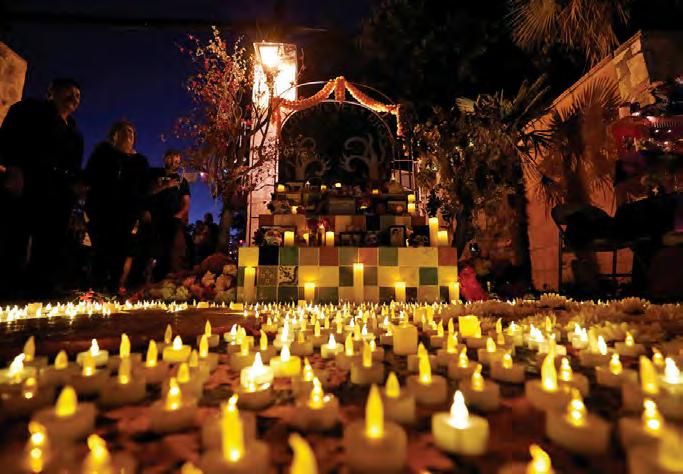
By Robert Matsumura, Contributing Writer
Every autumn, as the air grows cool and crisp and the trees turn brilliant shades of gold and scarlet, Mexico becomes a whirl of vibrant colors and music. The fall season ushers in the Day of the Dead — Día de los Muertos in Spanish — a unique cultural celebration honoring the lives of those who have passed away. Though the name of the celebration sounds ominous, it is anything but. It’s a joyous festival that melds ancient indigenous traditions with Catholic influences, resulting in a dazzling tapestry of love, life and remembrance.
Central to the Day of the Dead is the belief that, once a year, the departed souls of loved ones return to the world of the living for a reunion with their families. These souls, whether they be the spirits of honored ancestors or beloved pets, are welcomed back with offerings of their favorite foods, drinks and mementos from their lives. Families construct ofrendas, or altars, decorated with candles, photographs and colorful papel picado — ornate paper cut-outs that flutter in the breeze. With its bright orange petals, the marigold, or cempasúchil, is everywhere, its sweet fragrance serving as a guide to draw the spirits home.
The two-day celebration, every November 1st and 2nd, corresponds on the Catholic calendar to All Saints’ Day and All Souls’ Day. The first day is focused on the souls of children, known as angelitos (little angels) while the second day is dedicated to adults.
What makes the Day of the Dead so special, however, is not just its pageantry, but a continual connection with loved ones that transcends the finality of death. Families gather in cemeteries, often staying overnight, to clean and decorate graves, share stories and celebrate with music and food. Frequently, entire communities join together for processions and parades, where everyone is invited to join in the festivities.
An important part of the Day of the Dead is the food. Each dish bears symbolic significance. Pan de muerto, a sweet, anise-flavored bread decorated with bone-shaped designs, is a classic treat. Sugar skulls, often personalized with the names of departed loved ones, are a sweet reminder of the cycle of life and death. Mole, tamales, and atole (a warm, spiced corn drink) are other traditional offerings, each selected for its connection to the deceased one’s tastes or the family’s heritage.
More than just a time to remember those who have passed, the Day of the Dead is a celebration of life itself. Rather than something to be feared, death is viewed as an integral aspect of the human experience. By honoring those who have departed, their memories are kept alive, thereby ensuring they continue on as a vital part of our lives.
So should you find yourself in Mexico during these magical days of autumn, embrace the celebration. Savor the delicious traditional foods, dance, and above all reflect on how, in celebrating the dead, we are also embracing the enduring beauty of life.











By Patti Jo Brooks, Contributing Writer
Woodburn’s treasured Masonic building proudly displays a reconstructed façade and an interior reminiscent of its original design. Receiving grants which facilitated the restoration and preservation of the historic structure, the project saw completion last June. Home of Woodburn’s Freemasons Lodge #106 since 1905, both the Masonic building and the Lodge are a significant part of Woodburn’s history.
Original construction on the historic building began in the late 1890s, initiated by Freemason Jessie Settlemier, Woodburn’s founder, who unfortunately did not live long enough to see its completion. Jessie’s brother, Frank Settlemier, a prominent local businessman and Oregon’s Grand Master of the Freemasons, completed the Masonic building in 1905.

brothers and society.” Both Derickson and Donnelly have been instrumental in the completion of the historic remodel of the Masonic building.
Privately owned and headed by a board of trustees, in 2010 the Masonic building went without a revenue source for about two years when the storefront tenants went out of business. “That led to an effort about collaborating to bring our historic building back up to original standards and make sure that it was preserved for future use and continue its presence in the community,” Scott relates.

Scott Derickson, current Master of the Woodburn Lodge, points out that for the last 135 years Woodburn’s Freemasons have been an integral part of the community, carrying on the traditions and ideals of the Masons of Europe and those of the Founding Fathers of the United States Constitution, many of whom were also Freemasons. Scott goes on to explain that the Masons are “a fraternal organization built around ideals such as ‘all people are created equal.’”
John Donnelly, a past Master of the Woodburn Lodge, tells us that the square and compass not only signifies the mason’s trade, but can also serve as a reminder for “always trying to be a forthright, straight, truthful person within the circle of your

Jamie Johnk, Economic Development Director of the City of Woodburn, shares that over the years, the storefront was modernized, the transom windows were changed out and the awnings removed.
“It had a beautiful cornice when it was first constructed,” she states. However, the 1993 earthquake damaged the cornice at the roofline and it was removed. Leakage from the roof also caused significant damage to the interior walls, woodwork, and flooring.
Consulting with the State Historic Preservation Office, “we were able to identify the characteristics that made the historic building special,” Jamie says. As a result, the project received an Oregon Main Street Revitalization Grant, offered through the Oregon Parks and Recreation Heritage Program. Furthermore, the project was awarded a grant from the Woodburn Urban Renewal Program as well as some additional funding from the Masonic Lodge itself.
Utilizing original historic photos, “we worked with the local contractors to create and restore historic elements of the building,” Jaime comments. “Now we’re working with the Masons to get the building on the Historic Registry so it is preserved for perpetuity.”
Anyone interested in learning more about Woodburn or Oregon Freemasonry can contact the Oregon Grand Lodge at oregonfreemasonry.com or by calling 503-357-3158.
Are







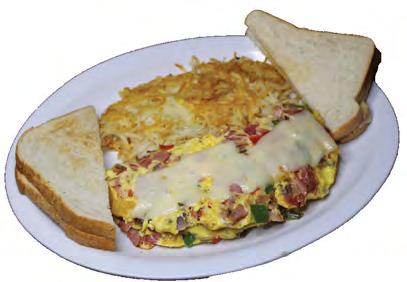









Local farm hosts Fall Festival and pumpkin patch

By Patti Jo Brooks, Contributing Writer
Pumpkins and corn, oh my! Families, farm stands and much more! For Willamette Valley Melon Company, October at the farm means a dawn to dusk self-serve pumpkin patch, overflowing farm stands and the Fall Festival, which brings family and friends together for a unique farm experience. The Fall Festival will be held this year on October 12th 10 a.m. - 8 p.m., with the “Pumpkin Glow” at 7 p.m. A visit to this local Molalla farm (or one of their roadside stands) this month will have you walking away with armfuls of farm-fresh produce - and maybe a pumpkin or two! The company mission, “Grow Stronger Communities. Grow Fresh Food for Our Community. Connect Families to Agriculture,” applies to all aspects of their farming, harvesting and retailing business. Although the pumpkin crop “is our largest crop by acreage,” notes Horticultural Director and co-owner Neal Lucht, “We are famous for local watermelon.”
Depending on the weather, some years these two crops are obliged to share the October spotlight. If things work out, you might just leave with a pumpkin under one arm and a watermelon under the other.
Watermelons aside, however, nothing signifies fall quite like pumpkins.
Growing over 40 acres of pumpkins in all shapes, textures and sizes to use in decorating, carving jack-o’-lanterns or making pies, you can either venture into the fields and choose your own, or select a pre-picked pumpkin conveniently sorted by variety.

Willamette Valley Melon Company’s main farm stand in Molalla offers the largest selection of produce available from the farm May through November. Acorn, butternut and delicata squash, as well as popcorn (which is grown, harvested and packaged at the farm) are some of the popular fall selections. The offsite roadside stands are open through October and all stands are self-serve, relying on the honor system for purchases. Chosen at peak season for quality, flavor and freshness, produce at the stands is restocked daily. If you’re interested in a wholesale opportunity, give the office a call at (503) 651-3302 (they’re open Monday-Friday 8 a.m. to 4 p.m.) or send an email to info@wvmelons.com.
As a majority woman-owned business, Pamela (Neal’s wife) serves as Finance Director and principal owner, and their daughter Lauren Lucht-Lovelace serves as CEO and company manager with a background in agricultural education and communication.

Looking toward the event, the team’s declaration, “We love any excuse to have a good time!” rings loud and true throughout the community. Focusing on the festival, HR Manager and CoEvent Coordinator, Darci Abeln, shares some of the details. In addition to the traditional kids’ activities (face painting, pumpkin painting, sensory bins,

scavenger hunt and hay pyramid), a five-acre custom designed corn maze and a photo-op are featured and included with admission. Tickets are available through the website. Also included on the day of the festival is an evening “Pumpkin Glow” event. Darci explains, “Attendees will be able to carve pumpkins throughout the day at the festival. These will be added to others already carved and we will display all the pumpkins
together and light them simultaneously at 7 p.m.” Sounds stunning! Neal, having grown up on Dryland Road raising irrigated crops on a family farm, started a seed and nursery company in 1990 known as North West Transplants with his wife Pamela. When neighboring property came up for sale about 10 years ago, they bought the 100 acres with the goal of bringing “high-quality products directly to the consumer with an emphasis on education,” Neal relates. Willamette Valley Melon Company strives to do just that. Maintaining close ties with the community, in addition to seasonal programs and events, the

Lucht family is a major sponsor for Oregon FFA and a sponsor for Oregon Aglink “Adopt a Farmer” program, which pairs a middle school classroom with a farm or ranch so students can build relationships with farmers and help give a voice to agriculture.
Willamette Valley Melon Company’s main office is located at 32300 S. Dryland Road in Molalla. For information on events or wholesale inquiries call (503) 651-3302 or email info@wvmelons.com. Access Instagram via @wvmelons for what’s available at the stands. For roadside stand locations and a myriad of other information, visit the website wvmelons.com.




By Oregon Black Pioneers
Photos Courtesy of the Grant County Museum
Christopher Columbus Sewell was a miner and entrepreneur and the patriarch of a successful Black family during Eastern Oregon’s gold rush years. Sewell was born in Washington, DC in 1823. His mother Maria was granted her freedom in 1827, along with Columbus and his five siblings.
It is believed that Sewell left Washington, DC at an early age. Later in life, he would claim to have fought under General Winfield Scott during the Black Hawk War, a US Army campaign against the Sauk and Kickapoo tribes in Iowa. However, this war took place in 1832, when Sewell was just 9 years old. What is certain, though, is that Columbus Sewell was counted in the 1850 census for Iowa County, Wisconsin.

Columbus moved further west in search of gold following the 1849 California gold rush. He worked as a miner throughout the 1850s in northern California, and appears in the 1860 census as a resident of Weaverville, in Trinity County.
Two years later, gold was discovered in Canyon Creek, a gulch near present day John Day, Oregon. A boom town emerged, which became known as Canyon City, and it soon became the county seat of Grant County. Many Californians migrated north to Canyon City, including Columbus. He worked as a ranch hand for prominent rancher Bradford Trowbridge from 1862-1865 before establishing a gold claim of his own.
The Civil War came to an end in 1865, emancipating enslaved African Americans nationwide. Sewell took a trip east at some point after the war and returned to Canyon City in 1868 as a married man. His new wife, Louisa, was a native of Richmond, Virginia. Columbus and Louisa made their home in town and raised two sons, Thomas (born 1869) and Joseph (born 1872). The Sewells were all prominent figures within the local community,

and were members of the Methodist Episcopal Church. Each of them was mentioned frequently in the social pages of the Grant County News.
Columbus likely continued working his gold claim, but sources show that he was working as a teamster, or wagon driver, by 1865. In that role, Sewell transported raw materials like lumber and wool to points as far away as Baker City and The Dalles. He would return with his wagons loaded with food, goods, and supplies. Columbus’ business was very successful. At one point he had as many as 12 horses pulling his fleet of wagons. Once, during a blizzard in 1884, Sewell famously cleared snow from the streets of The Dalles by affixing a snowplow to his wagon, which allowed stranded travelers to continue on. Sewell was still hauling freight by wagon as late as 1891.

In 1892, Columbus filed a Homestead Act claim for 160 acres of land four miles south of town. This claim would be certified in 1897. Sadly, the Sewell family did not get to enjoy this land together. Louisa passed away in 1893 and their son Joseph died of a self-inflicted gunshot wound in 1898. Columbus would pass away in 1899, leaving his homestead and business to Thomas Sewell. Thomas continued living and working in Canyon City until his own death in 1943.
The Sewells are remembered not only for being Eastern Oregon’s first Black family, but also for their friendship and generosity towards their neighbors in Grant County.
Oregon Black Pioneers is Oregon’s only historical society dedicated to preserving and presenting the experiences of African Americans statewide. To learn more, and to support this nonprofit, visit oregonblackpioneers.org.
©Oregon Black Pioneers, 2024













By Gretchen Van Lente, Contributing Writer
You hear people talk about the hauntings at Baker Prairie Cemetery. Everyone knows someone who knows someone who knew the next door neighbors who said it was definitely haunted. Children see dead people and even talk to them. One particular ghost wears a black suit and leather hat and holds a briefcase, staring down at a grave. If you try to talk to him he disappears, or he strolls away through the mist on Knightsbridge Road. He may even try to follow your car at spectral speed. You can never forget the chilling stories. But the stories differ greatly if you talk to Theresa and Samantha St. Clair. They share the fence with the cemetery, and they’ve never seen one single ghost in the 18 years they have lived there. However, they have seen things.
In 1850, the Donation Land Act in Oregon allowed “married white men and half breed Indians” to claim as much as 640 acres. In Canby,
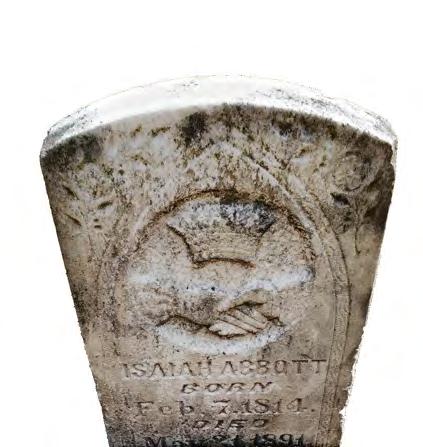
the history of the Pioneer Cemetery began in 1852, when J. Wesley Joslyn sold one acre of his donated land grant to his community for $1. The community at that time was called Baker Prairie, and that image gives us a picture of what the Cemetery looked like before we began burying our noble citizens there — perhaps a prairie grassland buzzing with bees, birds and butterflies. Out
with the Knights, the Lees, and the Macks, the founders and the pioneers are buried where giant conifers stretch long shadows across their graves. Theresa and her daughter Samantha often sit fireside next to the cemetery fence, and people looking at the graves do sometimes hang over the fence with typical questions. The St. Clair’s have to disappoint them, however, saying they have never once seen a ghost inside the graveyard. They have, however, seen things inside their house, a big bluegray two story with an expansive yard. 18 years ago, they had just moved in. Boxes were everywhere. As they told this story,




an enormous and annoying cat wound around the yard, making himself at home. They’d never seen the cat before. “We’ve had a couple little weird things happen in the house,” said Theresa.
Sam was about five years old in the retelling. Theresa was moving into her new house beside a graveyard. She went upstairs to start unboxing toys in the playroom and she found a stuffed animal sitting on the landing. Since she was home alone, it was somewhat unnerving, but she tossed it inside the playroom without too much worry. Later she returned to the playroom and the stuffed toy was sitting on top of all the boxes. After that day. Samantha doesn’t like to be alone in the playroom. It makes you wonder if, perhaps, the stuffed
toy was once a cat, like the big stray tramping all over the yard like he’s been there before.
The St. Clair’s spy interesting people in the graveyard, especially on nights with a full moon or Friday the 13th. They recalled a Goth student
— dressed in all black — shooting his senior pictures there. “Why did I not think of that?” joked Sam. Another interesting visit came from a group of five women and two teenage girls — but they were not a witch coven, as any reasonable person would imagine. They stood in a semicircle and hummed the rosary.
Today, people like to stop by at the end of a walk and stroll around. “It’s surprising how many people come,” said Theresa. She does observe what goes on in the cemetery. It feels right to keep watch, and other neighbors do as well. Thankfully, people remain respectful of the old graves.


Sam recalls how many sleepovers she had as a kid, “pretty much every year for my birthday.” Her friends wanted to sleep next to a graveyard. They found it plenty scary, but she never did.
“I’ve lived here my whole life,” she said. Theresa and her daughter Sam aren’t put off by the threats of ghosts, not even on All Saints Night. If you want the chance to see a ghost or maybe just some spooky dancing shadows, stop by Baker Prairie Cemetery on some moonlit night, maybe even Halloween.


By Kelly Romo, Contributing Writer
In 1974, John Lombardi founded John’s Waterproofing with a simple but powerful vision: to protect homes from the damaging effects of moisture in basements and crawl spaces. Initially, Lombardi handled all aspects of the business himself, working tirelessly to build a foundation of trust and excellence. His commitment to delivering high-quality service allowed the company to expand significantly, evolving from a one-man operation to a thriving family-owned business with a reputation for innovation, integrity and customer satisfaction. As the company celebrates its 50th anniversary, it’s clear that John’s Waterproofing has grown and evolved while remaining true to its roots.

John’s determination and hands-on approach allowed the company to steadily grow for the first couple of decades of its operation. The waterproofing industry, however, began to shift in the 1990s with the introduction of products specifically formulated for basement and crawl space waterproofing on the East Coast.
A company called Contractor Nation dove into the science of waterproofing by crafting products and processes that could provide long-lasting solutions for belowgrade spaces. To ensure John’s Waterproofing offered the best to his neighbors across the PNW, John learned about these new
advances, testing and tailoring them to provide region-specific solutions that set them apart from competitors.

A pivotal moment in the company’s history occurred in 2019 when long-time employee Robin Ekloff took over ownership when John retired. Ekloff, who has worked for John’s Waterproofing since 1997, ensured that the transition was smooth, maintaining the same level of service and integrity the company was known for. Under Ekloff’s leadership, the company has continued to thrive and innovate. Adding new services such as electrical work, Cummins whole-home generators and radon mitigation, John’s Waterproofing has positioned itself as a comprehensive home health solution provider.
Over the last five decades, the waterproofing and foundation repair industry has seen tremendous technological advancements, and John’s Waterproofing has consistently remained at the forefront. One of the most significant innovations is the CleanSpace® crawl space vapor barrier, which is a 20-mil thick woven material designed to completely seal out groundwater. This system helps protect homes from moisture and mold and deters pests while improving energy efficiency. In addition to CleanSpace®, the company offers the TripleSafe™ sump pump, which ensures that below-grade spaces always stay dry by efficiently pumping water away from the foundation. John’s takes pride in improving indoor air quality by keeping the space dry at all times to prevent mold spores and allergens from reaching the living areas above.
As a familyowned company, John’s Waterproofing has always placed a strong emphasis on creating a positive work environment and fostering a sense of integrity throughout its operations. Many employees are family members or long-time staff who have become like family. This strong internal culture ensures that every employee is dedicated to delivering the best possible service to customers. Ekloff has continued Lombardi’s practice of leading by example, reinforcing a culture of honesty, reliability, and community service.

The company’s commitment to integrity extends beyond its workforce. John’s Waterproofing is heavily involved in community initiatives, supporting Habitat for Humanity, local schools, the Silverton Area Community Aid (SACA) and the Mount Angel American Legion. By actively participating in these efforts, the company not only helps improve the lives of its neighbors but also reinforces its role as a trusted community partner.
Since taking over in 2019, Ekloff has introduced several new product lines and services to help grow the company. One of his key initiatives has been expanding the company’s offerings to include home electrical services and installing Cummins home generators. With these new additions, John’s Waterproofing provides comprehensive solutions to homeowners, ensuring their homes are protected from water damage and equipped to handle

power outages and other potential hazards. Despite the challenges of navigating the COVID-19 pandemic, Ekloff has successfully grown the company, and it continues to thrive.
Looking ahead, John’s Waterproofing is preparing for new industry trends. One of the most significant shifts has been the growing demand for basement finishing as more people work from

home. Before converting a basement into a livable space, homeowners must ensure it’s appropriately waterproofed to avoid costly repairs later on. John’s Waterproofing offers specialized services to help homeowners protect their investment and create additional square footage in their homes.


As John’s Waterproofing celebrates 50 years of excellence, the company remains committed to providing topquality waterproofing services and helping homeowners create healthier, safer living spaces. Whether you’re dealing with a wet basement or a damp crawl space or simply want to improve your home’s air quality, John’s Waterproofing offers free inspections and personalized recommendations to meet your specific needs. To learn more, visit their website at johnswaterproofing.com or call them at 503-873-5650.












By Patti Jo Brooks, Contributing Writer
One of Canby’s treasured historical buildings, the Mark Prairie Schoolhouse, continues to make strides with its reconstruction. The exterior of the damaged schoolhouse saw completion earlier this year, and of late the interior has been receiving all the attention. Remarkably, the original fir floors from 1879, suffering from exposure and pools of standing water, managed to withstand the elements and remain intact. The anticipated August completion date was set aside to accommodate other construction in the area taking priority. Hopefully, the Schoolhouse will now be completed by year’s end.
Relying heavily on donations and volunteer help, the Mark Prairie Historical Society “Save the Schoolhouse” campaign has witnessed the Canby community coming together to preserve this piece of the past. Canby Rotary Club donated $4,000 to the project and its members and volunteers recently built a porch on the northwest end of the building; they also cleaned and painted the vestibule. A recent Clackamas County TDC SIP Grant for $100,000 will go a long way toward completing the project. “We can’t be sure this will cover all the remaining costs,” explains Judi Aus, MPHS president. “Prices keep rising and some unplanned upgrades are needed that we didn’t anticipate.”
Community volunteers and public donations are still needed to ensure a quality finish for the 1632-square-foot structure which includes the 1893 vestibule that originally served as a mud porch, and the kitchen annex added in 1849 utilizing an

existing woodshed. Once completed, the schoolhouse will again serve as a meeting place for local community events, just as it has since 1946 when School District 38 ceased to operate at Mark Prairie School. The Mark Family’s generous gift of the site to the community 78 years ago continues to provide a meeting place for local 4-H Clubs, Boy Scouts, weddings, reunions and any other gatherings that serve the needs of the community.
“One of the reasons we’re working so hard to save the schoolhouse is that it helps the young people understand the importance of preserving history through historical buildings. It also gives the community a place to hold small events, and it attracts tourists to the farm community,” Judi explains. “I feel that it adds charm to the country landscapes.”

Still seeking a part-time inaugural site manager, Mark Prairie Historical Society asks anyone who might be interested to please step forward. What better way to become involved with your community? Booking events, overseeing the grounds before and after events and helping with fundraising are a few examples of what a site manager would be asked to do.
To learn more about the Mark Prairie Schoolhouse, the Mark Family, reconstruction updates, online donations, volunteerism and becoming a member, visit markprairiehistoricalsociety.org. Donations can be mailed to: Mark Prairie Historical Society, 7528 S Mark Rd, Canby, 97013. For inquiries, call 503-353-6563 or email info@markprairiehistoricalsociety.org. Mark Prairie Schoolhouse is a 501(c)(3) nonprofit.

The Woodburn Fire District proudly placed new Engine 21 into service at the district’s main station located on Newberg Highway.
The new engine, financed by a bond approved by voters in 2021, represents a significant investment in the district’s ability to serve the rapidly growing communities of Woodburn and Gervais.



exception, and voters reaffirmed their support by renewing the five-year levy in 2023 with an 83% approval rate.
The new engine is part of a larger purchase of nine new fire apparatus, including two master tenders, two brush units, two engines, an air unit, and two staff vehicles. Three of these new vehicles will be assigned to Station 23, which is currently under construction on Butteville Road, between Gervais and southwest Woodburn.
The engine being replaced at Station 21 will be reassigned to Station 22 on the east side of Woodburn on James Street. The fire district began staffing the James Street station in early 2022 with four career firefighters on one of three shifts. The district plans to gradually increase staffing at Station 22 as budget funds allow until all three shifts are covered.

Engine 21 will be continually staffed with a crew of four, including at least one paramedic. The district made a commitment during the 2018 operating levy campaign to maintain minimum staffing of four firefighters. The district has honored that commitment every day without

Chief Budge expressed his gratitude for the community’s ongoing support. “This investment allows us to retire equipment that has reached the end of its 30-year service life and ensures that we can continue to provide the highest possible level of service to the district’s 40,000 residents in north Marion County.”














We’re thrilled to announce that Amy Johnston has been named the new Executive Director of Todos Juntos! After spending a year learning from our founder and now retired Executive Director Eric Johnston, Amy is stepping into this role with enthusiasm and a deep commitment to our mission. Her hands-on experience over the past year, combined with her valuable insights, positions her perfectly to lead Todos Juntos into its next chapter.
Amy brings a wealth of experience as an educator, with endorsements in Language Arts, Theatre, and English Language Development for grades K–12. Her strong background, coupled with her Masters in Public Administration focused on Non-Profit Management, uniquely equips her to guide our team in delivering top-tier, evidence-based programs to the communities we serve in rural Clackamas County.
We are excited to see the impact of Amy’s leadership as she takes the helm of Todos Juntos. With her at the forefront, we are confident in our continued growth and our ability to make a lasting difference in the lives of individuals and families across rural Clackamas County!
This summer was all about adventure and creativity in Canby! Our Migrant Education Program took students on thrilling field

trips to Silver Falls, PSU, and local parks. They kicked off with laser tag to boost engagement, while activities like LED maskmaking and Sphero robotics sparked their imagination. One incredible success story involved a student learning both English and Spanish, gaining the confidence to deliver a presentation by the end of the program.
Our five-day soccer camp was a blast, with 19 kids sharpening their skills, learning teamwork, and making new friends every day. The joy on their faces as they mastered new techniques was unforgettable.
At the Canby Library, our weekly playgroups became a favorite for parents and kids alike. They dove into fun literacy activities, explored STEAM concepts, and connected with essential community resources — all while enjoying quality time together. Canby was buzzing with energy, learning and laughter all summer long!
This summer in Canby was packed with excitement, from field trips and soccer camps to weekly playgroups at the Library. Students built new skills, made friends, and had a blast!
Now, we’re gearing up for even more fun this fall with a fresh lineup of programs. Whether you’re looking to join an enrichment club or explore new activities, there’s something for everyone.
Get ready to jump in — fall programs are starting soon! Scan the QR code for a detailed calendar of all upcoming events.
Todos Juntos empowers youth and families through diverse programs and resources. Whether you’re seeking educational support, family resources, or community events, there are many ways to get involved. Scan the QR code to explore our programs, learn about our mission, and discover how you can help build a stronger, more connected community.





















LEARN how to



DISCOVER how to align investments with your specific goals.
MASTER the simple 5 Step Process to owning your first home.
EXPLORE the different investment options- and how they can work for you.
MEET & GREET with Lenders, Home Inspectors, Title Reps and other KEY players in your home purchase!






The destination is the same but the “route” is different. Meaning, there are a few new practice changes that are being implemented related to the purchase and sale of a home in the United States. Specifically:
1. Buyer’s Agents must enter into a written agreement that clearly discloses the details of the compensation that will be received prior to touring any homes.
2. Practice changes are moving toward all compensation being paid directly by the seller and/or the buyer. This is replacing the prior practice of “sharing” or “cooperation” of compensation between the listing broker and buyer broker.
3. Offers of compensation to a Buyer’s Agent may not be made on an MLS
Going forward, there will be no offers of compensation to the Buyer Broker made on the MLS. We expect that the Buyer Broker will contact the Listing Agent on a perproperty basis to get information on the Seller’s intent to pay Buyer Representation Compensation and use whatever information is provided, if any, to advise the Buyer and submit a request for Buyer Representation Compensation as part of the official offer process as may be appropriate.
There are 3 core agreements that govern a real estate transaction
1 2 3
Listing Agreement
This is the agreement between the Seller and the Listing Broker.
Buyer Representation Agreement
This is the agreement between the Buyer and the Buyer Broker.
The Purchase Agreement
This is the agreement between the Seller and the Listing Broker.
Agents must clearly communicate, educate and disclose at the earliest moment possible how compensation works in the real estate transaction, including that broker commissions are not set by law and are fully negotiable. Buyer Broker compensation must be objectively ascertainable (not open ended), and the Buyer Broker cannot receive any more compensation than that which is negotiated and agreed upon in writing.


By Patti Jo Brooks, Contributing Writer
by Brittany Jungenberg
Who is Kris Sallee? Yes, she’s Canby’s local insurance agent with HealthMarkets Insurance Agency, but let’s push that out a little further. Kris is a longtime local who grew up in Aurora and although she maintains a connection to her native state, she considers herself an Oregonian through and through. Kris can be seen “parading around” out and about in the Canby community sporting platinum locks and tooling around in her classic peacock ‘64 Mercury Comet Caliente. She’s easy to spot and in essence has become sort of a local brand!
Kris actively supports the community in any way she can. Sometimes it’s fun, sometimes it’s professional, but always, always, it’s caring. Whether she’s providing sponsorship at the Clackamas County Fair & Rodeo, hanging out with her Comet Caliente at Hope Village Senior Living, sponsoring a trophy at the Cutsforth Cruise-in or participating in Aurora Colony Days, Kris is 100% engaged. Particularly close to her heart is Aurora Emergency Preparedness, a local nonprofit that Kris serves as president and founding member. Riding on Matt Nelson’s vintage fire truck, the Aurora Emergency Preparedness team members made quite an impressive showing along the Aurora Colony Days parade route.

Kris also serves the community as a board member of the Canby Rotary Club. Additionally, she’s a member of the Canby Chamber of Commerce, the Aurora Pythian Lodge, and the Hope Village Foundation Board. She is also a member of Business Network International (BNI), a networking group in Oregon City. Within the scope of HealthMarkets Insurance, Kris continues to reach Gold Level standing in the Chairman’s Club and ranked 50 among the top national producers this year, earning a trip to Italy. To be considered for Chairman’s Club, agents must demonstrate a commitment to building their client base while providing a level of service that helps ensure a high degree of client satisfaction for years to come. Kris is highly successful, professional, yet humble and extremely caring.
As your HealthMarkets Insurance Agent, Kris realizes clients are filled with “unknowns.” Can I afford my health insurance? How can I best protect my investments? What happens if I lose my job or become seriously injured and unable to pay the bills? Kris tells us: “I consider it a consultative partnership with my clients by designing a health insurance strategy for their healthcare needs. My goal is providing

clients with the best protection by using a variety of policies, while keeping within their budget.”
Health insurance alone is not enough in today’s environment. It no longer covers medical expenses the way it did 20 years ago. HealthMarkets Insurance offers numerous products including individual plans for under 65, Medicare, Small Business, Life, and Supplemental plans like dental and vision. “I want them to have their personal corporate package,” says Kris, who is also a certified Oregon Health Plan enroller. “When I put a personal corporate package together it’s health insurance, supplemental, and life to protect their income should they experience a major medical event.” She consults with the client, identifies their needs, puts together a plan, and shows them “how these policies will work together to
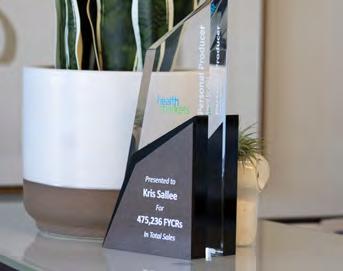
provide additional coverage for you.”
Annual enrollment for Medicare starts in October. For health insurance marketplace under age 65, open enrollment is Nov. 1, 2024 through Jan. 15, 2025. Kris and her team of qualified agents stand ready to answer any questions and help complete the enrollment process. Schedule a time to review your options to make an informed decision for your 2025
coverage by calling ahead or visiting calendly.com/ksallee and click on the service you need. Remember, services are always provided at no cost to you! There continues to be a growing need for qualified health insurance agents across the states. If you are thinking about a career as a Health & Life Insurance Agent, email Kris directly at ksallee@healthmarkets.com. She is available to anyone interested in exploring this opportunity.
Kris Sallee/HealthMarkets Insurance Agency is located at 1433 S.E. First Avenue, Ste. 103 in Canby. Call the office at 503-263-8200 or email ksallee@healthmarkets.com. For more information, visit healthmarkets.com/ local-health-insurance-agent/ksallee or facebook.com/HealthMarkets.Kris.Sallee. Licensed in OR, WA, AZ, CA, FL, MI, NM, NV and TX.
















By Robert Matsumura, Contributing Writer
Each autumn as October draws near, neighborhoods transform. Pumpkins leer from porches, skeletons and monsters festoon front yards, and children eagerly anticipate the thrill of trick-or-treating and the hoard of candy they will amass. But where did this creepy spectacle we call Halloween originate?
The answer to this stretches back over two thousand years to the ancient Celtic festival of Samhain (pronounced sowin). Celebrated on October 31st, Samhain marked the close of summer and the commencement of winter — a dark, cold, time associated with death in Celtic tradition. On the night before Samhain, the Celts believed the boundary between the living and the dead grew thin, permitting spirits to roam freely across

the earth. To ward off these visitors from the other side, people built bonfires and donned costumes fashioned from the heads and hides of animals.

Later, as the Roman Empire gained dominion over much of Europe, their festivals of Feralia (commemorating the passing of the dead) and Pomona (honoring the goddess of fruits and trees) merged with Samhain. This cultural fusion brought apple bobbing into the festivities. Pomona, the goddess of orchard fruits, was often depicted bearing apples, a symbol of the harvest and abundance. Incorporating apples into the holiday is a nod to Pomona’s influence — still seen today in bobbing for apples and the tradition of candy apples. As the centuries passed, celebrating the harvest and honoring the dead were integrated into Halloween traditions, blending Roman and the older Celtic customs together as something new.
Fast forward to the 8th century when Pope Gregory III declared November 1 as All Saints’ Day or All Hallows’ Day, to honor saints and martyrs. These new holidays were part of a broader strategy by the Christian church to replace pagan festivals with Christian ones. As time passed, the night before October 31, became All Hallows’ Eve — morphing eventually into Halloween. It was during this period that traditions like souling and guising emerged, where the poor went door to door requesting soul cakes in exchange for their prayers on behalf of the dead. It was this tradition that evolved into what we know today as trick-or-treating.
The jack-o’-lantern, one of the most iconic symbols of Halloween, has its own fascinating origin. The tradition of carving faces into vegetables predates Halloween and originates from ancient Irish folklore. According to the story, a man named Stingy Jack attempted to trick the Devil and was condemned to roam the earth with only a lantern fashioned from a carved-out turnip to light his way. In Ireland turnips were used for this purpose during Halloween festivities, but upon reaching the New World, Irish immigrants discovered that pumpkins, native to their new home,


were larger and easier to carve. This practical switch gave rise to the nowfamiliar jack-o’-lantern, a central feature of Halloween décor to this day. Halloween continued to evolve in the New World. In colonial America, European traditions integrated with indigenous harvest festivals creating new customs. While many American colonists celebrated Halloween with activities such as fortune-telling, dancing and communal gatherings, the Puritans, due to their strict religious views, frowned upon Halloween festivities, deeming them to be pagan and irrelevant. Despite puritanical naysayers, the 19th century saw Halloween expand into a communitycentered event with activities like parades, parties and mischief-making. Halloween also grew to be accepted by schools, churches and civic groups which began holding those same parties, parades and other festivities. As Halloween became a familyfriendly event, much of the raucous mischief-making of the past began to diminish. By the early 20th century, Halloween was celebrated from coast to coast as a national holiday.
In the decades following World War II, Halloween traditions were firmly entrenched with costumes, trick-or-treating and spooky decorations taking center stage. Instead of the laborious handsewn costumes of the past, factories now massproduced inexpensive costumes that made dressing up for Halloween a snap. As Halloween became increasingly commercialized, themed parties, haunted houses and an expanding array of Halloweenthemed merchandise became the norm.

Today, Halloween’s popularity has only burgeoned. Contemporary trends run the gamut from spooky movie marathons and elaborate haunted attractions, to viral social media challenges and interactive experiences. Year-round Halloween shops exist to satiate your spooky urges. Halloween has even expanded the ghostly season to stretch beyond October 31, with Halloween promotions and events commencing as early as September. So commercially successful is Halloween from a business standpoint that it stands second only to Christmas in terms of revenue generated — a testament to its enduring appeal across generations.
As the air grows chill and the trees turn red and gold, remember that Halloween is more than just candy, costumes and jack-o’-lanterns. It’s a tapestry woven from ancient rituals, Christian traditions and the spiritual beliefs of numerous cultures spanning centuries. It’s a time to embrace the spooky, celebrate community and be on the lookout for spirits that may stalk the earth at this sacred time of year.
So as you don your costume and select a pumpkin for carving, take a moment to ponder the ancient roots of this beloved holiday. Whether you’re young or simply young at heart, Halloween is an invitation to revel in the mystery of the unknown, celebrate the cycle of life and death, and to maybe even bob for an apple or two. And as the last light fades on All Hallows’ Eve, the timeless allure of things that go bump in the night is sure to embrace you once more.

By Patti Jo Brooks, Contributing Writer
The universal language of music speaks to every age and every culture. Presenting their 47th season of worldclass performances, Western Oregon University enriches the community with the Smith Fine Arts Series. Free to students and reasonably priced for community members, Smith Fine Arts Series has an amazing and diverse lineup for the 202425 season. Mark your calendars. Come as you are. Join friends, family and students at Leonard W. Rice Auditorium on Western’s Monmouth campus to experience the power of live performance!
A season that promises “to be among the best yet,” six performances, spanning October 11th to June 7th, will include a diverse lineup from mariachi to a string quartet that features not only Bach, Mozart and Beethoven, but contemporary composers as well. Cultural diversity and inclusion is the Western way, and the Smith Fine Arts Series is no exception!
In addition to presenting top notch music and dance performances, Smith Fine Arts Series also provides free educational outreach throughout the season, made possible through its subscribers. Special performances, informal discussions, and workshops for university students and the public are part of the program as well. Subscribers enjoy priority seating, discounted tickets and invitations to special behind-the-scenes events and more.
Leonard W. Rice Auditorium is an intimate venue that engages the audience with the performers in an experience that some describe as “life changing.” Easy ticketing, free parking, and great dining close by make attending the Smith Fine Arts Series a hassle-free cultural arts evening.

This season’s 2024-25 Smith Fine Arts Series lineup includes:
Oct 11 – Lucia Micarelli & Leo Amuedo: Micarelli, a violinist, singer and actress and Grammy-nominated guitarist Amuedo have performed with numerous world-renowned artists.
Dec 7 – Grupo Bella: While their instrumentation is familiarly mariachi, what emerges is an enticing fusion of Mexican Pop, Boleros, Huasteco and more.

Jan 8 – Emily Branch: This contemporary repertory concert features dance works spanning 13 years, original musical compositions, poetry, and a dynamic cast of five magnetic dancers.
Mar 15 – Marty Isenberg’s Wes Anderson Playlist: Bassist Marty Isenberg and his ensemble of talented musicians capture the melancholy, wonder and precision of filmmaker Wes Anderson.
Apr 12 – BEO String Quartet: Founded by two MexicanAmerican brothers in 2015, the eclectic and highly polished BEO String Quartet is a daring, genre-defying ensemble.
Jun 7 – The Revelers: The Grammy-nominated Revelers have created a “Louisiana jukebox” that is at once modern and traditional.
All performances begin at 7:30 p.m. in the Leonard W. Rice Auditorium (corner of Knox St N and Powell St E) on Western Oregon University’s Monmouth campus. Get your tickets at wou.edu/smith.
The Smith Fine Arts Series administrative office is located in The Cottage, Room 105 on the WOU campus. Call (503)8388333 or search wou.edu/smith for additional information.



components, which required him to search through numerous wrecking yards. A crucial front nose piece was missing, but he eventually found a fiberglass replacement.

By Kelly Romo, Contributing Writer
Rodger Busse is an avid car enthusiast and dealer of the innovative product known as The Rust Doctor, which effectively stops rust on metal surfaces. About twelve years ago, Rodger embarked on a journey to combine his passion for car restoration with his product business by acquiring and restoring a unique 1969 Pontiac ambulance. This restoration project brought the vehicle back to life and served as a marketing tool and conversation starter at auto swap meets and car shows across the country.
The 1969 Pontiac ambulance is a remarkable piece of automotive history. Originally manufactured with a standard Pontiac frame, hood and front doors, it was sent by rail to an ambulance manufacturer. They extended its frame to twentyfive feet and added a fiberglass top and side fenders to complete its transformation into an ambulance. The back door was reminiscent of a large station wagon, providing ample space for patient transport.
The ambulance began its journey in New York but made its way westward, one fire station at a time, where Rodger found it sitting unused at a department in Arizona. Once he saw its potential and purchased it, he immediately set to work restoring it to its former glory. Rodger personally handled most of the restoration, including the use of The Rust Doctor product to combat existing rust.
One of Rodger’s most significant challenges was finding replacement parts, especially for the ambulance-specific





In addition, all the upholstery needed replacing, as it had become cracked and faded over the years. Despite these obstacles, Rodger completed the main restoration in just 12 months, though he continues to make minor improvements to the vehicle as needed.
When the ambulance was manufactured, it featured some advanced technologies for its time. It was equipped with a two-way radio, and its lights and sirens were considered state-ofthe-art. The ambulance lacked modern medical equipment, however, and served purely as a transport vehicle, with no onboard medics or life saving devices. The ceiling had hooks for a second gurney, in stark contrast to today’s ambulances. Back then, ambulances were often parked at taxi services, and taxi drivers would operate them when a call for medical transportation came in. Occasionally, they were stationed next to morgues, and drivers would take the wheel as needed.
A particularly whimsical addition to the restored ambulance is “Rusty,” a mannequin dressed as a nurse. She is seated in the back beside a pedal car rigged with inverted Rust Doctor bottles, simulating an IV drip. This setup cleverly ties the ambulance’s purpose to Rodger’s business. The restored ambulance has appeared at various community events, including the Cutsforth’s Car Show, the Hot Rod Dreamworks Car Show, and the Canby Parade.
As Rodger continues to showcase The Rust Doctor ambulance, it serves as a tangible piece of history, reminding people of how far automotive and medical technologies have come. This makes it an unforgettable icon in the world of classic car restoration.













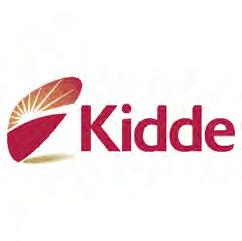



















“Who you gonna call?” There’s nothing like the original Ghostbusters, and the reboots aren’t even worth watching in my opinion. Not one but two sci-fi action-comedies star a legendary cast, including Bill Murray, Dan Aykroyd, Harold Ramis, Ernie Hudson, Sigourney Weaver, Annie Potts, Rick Moranis, and more. Parapsychologists turned ghost hunters in New York City end up saving the world twice — from an ancient god, Dozer, hellbent on destruction, and the Stay Puft marshmallow man (Ghostbusters I), and then again from a psychoactive pink slime flowing under the city, and a 16th century sorcereralchemist Vigo the Carpathian who wants to be reborn in the 20th century. The movies are occult, spooky, funny, actionpacked, and great for the whole family. Rated PG, but with strong language and mature themes it’s more like PG-13.

Stream these movies where available, or rent from your local movie store, library or rental kiosk.

“Without even thinking about it, I used to be able to fly. Now I’m trying to look inside myself and find out how I did it.” This heartwarming anime follows the journey of 13-yearold Kiki, a young witch who moves to a quaint seaside town with her loyal talking cat, Jiji. As part of the tradition in her village, Kiki must spend a year living on her own to complete her training as a witch. Armed with her broomstick, she quickly learns to harness her flying abilities and starts a unique delivery service, delivering packages to the town’s residents. The movie captures Kiki’s growth and the challenges she faces — she becomes part of the community and yet her confidence begins to waver, leading her to lose the magic that once came so easily. And the animation is utterly stunning. Rated G.

“How’s that for a slice of fried gold?” The movie opens with an homage to London citizens going through their work days like zombies, arguably showing how complacent and boring our lives have become — only when threatened, like our primordial days, do we truly live again.
Once the zombie outbreak takes hold, things get exciting. Shaun, an AV salesperson, and Ed, a small-time weed dealer, are thrust into action to defend themselves. Once outside, they band together with friends and quest to their local pub, The Winchester. Billed as a rom-com with zombies, there are interpersonal subplots galore, including Shaun and Liz’s deteriorating relationship (Shaun isn’t spontaneous or romantic), Shaun and Ed’s one-sided friendship, Shaun’s rocky relationship with his stepfather, and jealous David whose love for Liz is unrequited. It’s gut-ripping gore hyperbole. It’s deeply funny with its dry British humor. And it’s action-packed. A zombie movie in its own right, it’s also an homage to George A. Romero. Directed by Edgar Wright and starring a huge cast with Bill Nighy, Peter Serafinowicz, Kate Ashfield and more. Rated R for language and graphic violence.
Freaky Facts
Halloween’s origins go back to the ancient Celtic festival of “Samhain,” the celebration of the end of harvest season. The Gaels believed that on October 31, the boundaries between the worlds of the living and the dead got a little blurry and the dead would come back to life and wreak havoc among the living. How to scare the dead? Wear costumes and masks.
The average American eats about 3.4 pounds of Halloween candy.
Try wearing your clothes inside out and walk backwards on Halloween. According to traditions, this will make sure you see a witch at midnight.
Did you know that even healthy people can have serious complications from the flu? Remember, a bad case of the flu can lead to:
• Missing work or important events
• Spreading illness to the elderly and people with weakened immune systems
• Costly hospital stays
Protect yourself! Wash your hands often, cover your coughs and visit Salem Health Medical Clinic in Woodburn to keep your vaccinations up to date.

Believe it or not, everyone can be an artist when it comes to pumpkin carving, but it is harder than it looks. Follow the following eleven tips, and your gourds will look and smell good the entire trick-or-treating season. Get carving!
Start with the right pumpkin.
Choose one that’s fresh, with a sturdy stem, no bruises, and a flat bottom so it won’t roll while you carve.
Cut from the bottom, not the top. Cutting your “lid” from the bottom of the pumpkin helps prevent the sides from caving in later.
If you carve from the top, cut lid on an angle. This way it won’t drop inside the pumpkin when you replace it, like it would with a straight up-and-down cut. A boning knife should work well for this.
Scoop out all the pulp (and then some).
You can buy a special “claw” for pumpkin gutting, but an ice cream scoop will do just fine. Thin the inner wall of the “face” area to 1¼-inch thick, so it will be easier to pierce the shell.
Sketch your design to size on paper first. Tape it to the front of your pumpkin. Using a fork or pencil, poke holes along the lines you want to carve.
Try holding the pumpkin in your lap.
It’s easier to create features when the face is gazing up at you. It is suggested to use a serrated kitchen knife or an X-Acto knife.
Start by making simple rough cuts.
If you get the big pieces of pumpkin out of the way first, you can go back and clean up the edges of your design later.
Use your scraps creatively.
Make a tongue, pipe, or hair accessories out of discarded pieces of pumpkin shell, for example.
Keep your pumpkin fresh.
Spread petroleum jelly on the cut edges to seal in moisture. If your pumpkin still shrivels a few days later, revive it with a facedown soak in cold water for up to eight hours.
Create a chimney.
First, leave the lid on for a few minutes while the candle burns. Cut a small hole where the pumpkin has blackened up top. Or, save yourself the stress and opt for a battery-operated votive.

Sprinkle cinnamon inside.
That way, when you light the candle, your jack-o’-lantern will smell like a pumpkin pie. Yum.





















